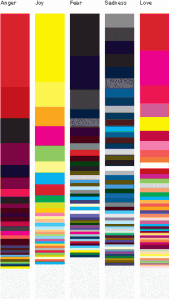Emotionally}Vague by Orlagh O’Brien
 Whenever I work with people on emotional regulation during conflicts, I like to ask where they feel the emotions in the body. Stress and emotional overload can show up as muscle tension, hair standing up, sudden headache, pit in the stomach, racing heartbeat, deep sighing or shallow breathing. The body reveals what the brain tries to conceal. We are wired to react fast to perceived threats. Often, by the time the mind catches up, adrenaline, cortisol and other stress hormones have already begun their work in the body, triggering the fight or flight response. If the threat is too overwhelming for the nervous system, the brain may numb the body through the release of opiates, sending us into a freeze. This may feel like we are not quite there, so we experience less pain and internal turmoil.
Whenever I work with people on emotional regulation during conflicts, I like to ask where they feel the emotions in the body. Stress and emotional overload can show up as muscle tension, hair standing up, sudden headache, pit in the stomach, racing heartbeat, deep sighing or shallow breathing. The body reveals what the brain tries to conceal. We are wired to react fast to perceived threats. Often, by the time the mind catches up, adrenaline, cortisol and other stress hormones have already begun their work in the body, triggering the fight or flight response. If the threat is too overwhelming for the nervous system, the brain may numb the body through the release of opiates, sending us into a freeze. This may feel like we are not quite there, so we experience less pain and internal turmoil.
The faster we can notice our physiological reactions, the more chances we have to dampen the amygdala activation, stop the emotional rollercoaster, and send the mental resources back to the prefrontal cortex where all the planning, decision making, and social control happen. It helps to practice emotional regulation in less threatening situations first to build up the resilience of the nervous system.
Therefore, I was thrilled to discover the Emotionally}Vague project about the body and emotion (Hat Tip to Kristin Butler @kirstinbutler on Twitter). This research project was launched by graphic designer Orlagh O’Brien and aimed to reveal patterns of visceral feelings in a visual, interactive manner. One of the steps in the survey asks the participants: “How do you feel these emotions in your body? Draw anything you wish.” The emotions are anger, joy, fear, sadness, and love. Orlagh O’Brien explains: “The answers were overlaid to create an averaging effect. It’s interesting to note how people draw around and outside the body and how the method reveals levels of intensity.”
You can see the results at http://www.emotionallyvague.com/results_02.php.
It is fascinating to see those patterns. Orlagh O’Brien’s method strikes me as a valuable tool in mediation and conflict coaching to help parties better express their emotions, understand each other’s reactions, ultimately learn to manage the self-defeating patterns, and perhaps, track changes over time.

